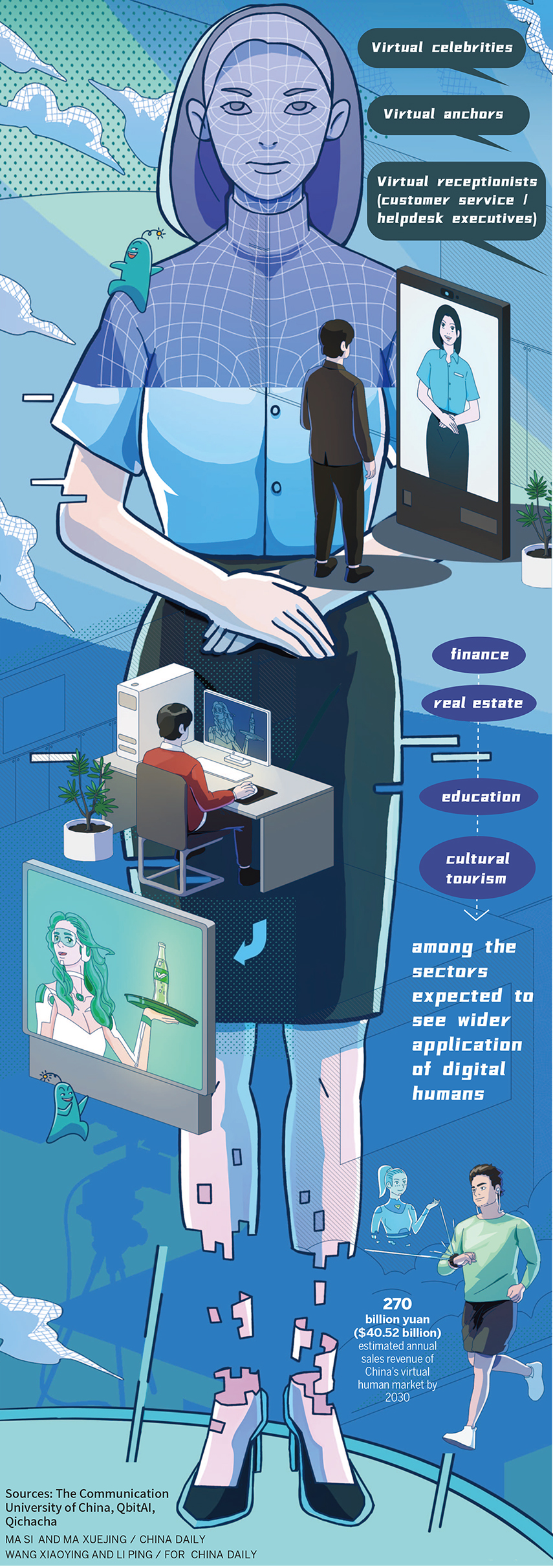AI puts virtual beings to wider applications
By MA SI and MA XUEJING | China Daily | Updated: 2022-06-06 09:23

280,000 firms vie to drive digital humans into finance, retail, governance, media, entertainment and automobile sectors
At a bank branch in Shanghai, an elegant female receptionist, dressed in a blue outfit, is welcoming customers. "Sensing" that customers are in a good mood, she becomes talkative and introduces more of the bank's wealth management services.
Aware that some customers are frowning, she becomes more cautious and does nothing more than answer the questions customers ask, such as how to print itemized bank account statements.
She was the first digital employee at the Shanghai branch of Bank of Ningbo. On a screen as tall as the height of normal human beings, she can also answer more than 550 common banking business questions and more than 3,000 supplementary questions.
Powered by an artificial intelligence system, she can learn to answer 50 new questions every day and with a camera on the screen, she can also tell whether customers are smiling or not, said Luan Qing, general manager of the digital culture and entertainment business at SenseTime, which developed the digital human technology.
The digital employee offers a peek into how a wider range of sectors are starting to embrace AI-powered digital humans to boost efficiency and increase resonance with customers. Thanks to rapid technological progress, virtual humans, which used to be only seen in the cash-intensive entertainment industry such as movies, are becoming more prevalent in people's daily lives and work, experts and company executives said.
From virtual anchors who broadcast news 24 hours a day to virtual dancers and singers attracting fans all over the world to a digital employee winning a Chinese real estate developer's best new employee award in 2021, digital humans are becoming smarter. They showcase how Chinese startups and heavyweights are scrambling to put virtual beings to wider applications, they said.
During the Beijing 2022 Olympic and Paralympic Winter Games alone, about 20 digital humans made their debut. They played different roles: AI sign language guides that explained the competitions to the hearing impaired among the audiences; weather forecast anchors; an Olympic public welfare ambassador; and livestreaming anchors that sell Winter Olympics souvenirs online.
Currently, more than 280,000 enterprises in China engage in businesses related to digital humans, with the compound annual growth rate of enterprises registered in the past five years reaching nearly 60 percent, data from Qichacha, a company that tracks business registrations, showed.
The popularity of digital humans is closely related to the concept of metaverse, a tech buzzword that has been gripping the global tech industry since last year. Digital humans are the avatars of people to enter metaverse, which promises an integration of virtual and real worlds, said Yu Jianing, co-author of the book Metaverse and principal of Huobi University, an educational and research institution focusing on frontier technologies.
























